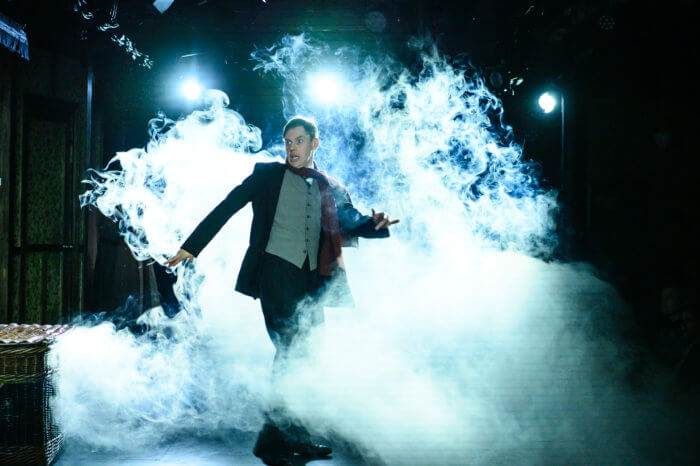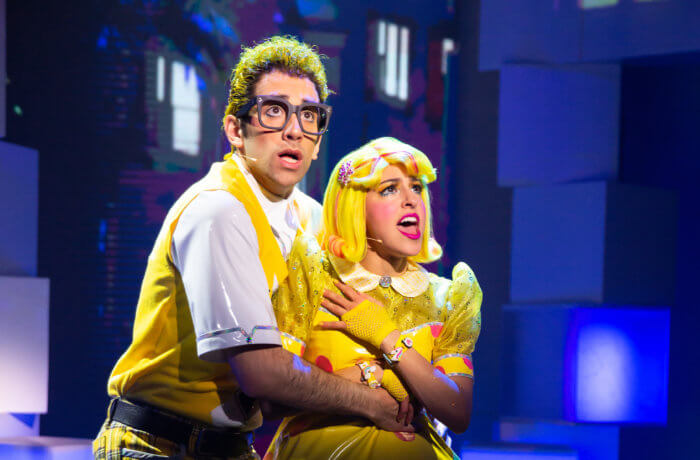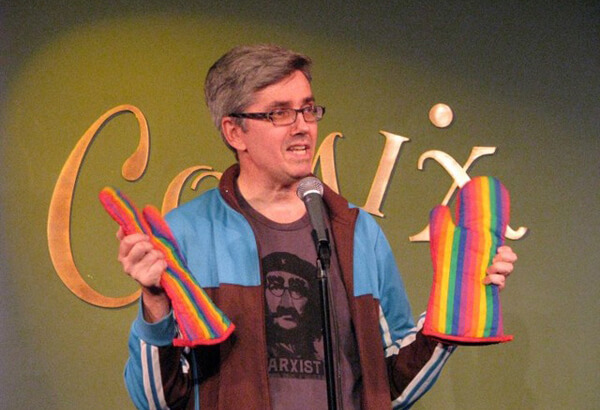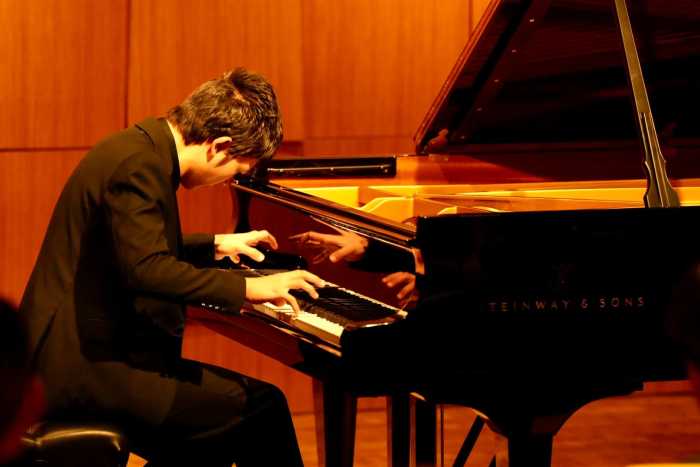If the relationships between parents and children weren’t complicated — and if the stories about them weren’t so often told — we could get rid of a significant portion of world literature. When such a tale is told with force, originality, and lyricism by novelist Elizabeth Strout, it is riveting and deeply moving.
Strout’s 2016, first-person novel, “My Name is Lucy Barton,” has been adapted for the stage by Rona Munro, and it is a spectacular 90-minute solo show starring Laura Linney in a luminous and unforgettable performance.
The story is a simple one. Lucy is looking back at events in her life as it is thrown into chaos by an infection that leaves her hospitalized for nine weeks. Her mother, who has never been on a plane before, flies to New York from rural Illinois to be with her. In the course of their time together, we learn about Lucy’s abusive childhood, her desire to become a writer, and her eventual escape to New York where she builds her own — happier for a time — family. Lucy’s mother is a plain-spoken, even abrasive woman whose hard expression masks a discomfort with authentic emotion yet who is clearly doing her best, even if the effect is often prickly. Perhaps most telling about their relationship is the moment when Lucy’s mother observes that Lucy wanted a different life… and just went out and got it. The combination of admiration and resentment is both honest and quietly theatrical. As the piece unfolds, we learn that Lucy’s journey is far from over and that she has indeed acquired some of her mother’s clear-eyed view of the world. The lesson in this is that we must never discount how our past has shaped us and that no matter how hard we try the influence of our parents is indelible.
Playwright Munro has, wisely, preserved much of Strout’s language and elegantly integrated moments of Lucy and of her mother. Linney is simply a marvel, seamlessly moving between mother and daughter in the telling of the story. Under the savvy direction of Richard Eyre, her performance is often beautifully understated, despite the outsized characterization of the mother, which draws the audience in and leaves them hanging on every detail. While the one-person show is an unforgiving form that can seem stilted, here the combination of Linney’s generous performance and Strout’s language is virtually perfect.
The scenic design by Bob Crowley and video design by Luke Halls are ideal in illuminating beautifully this world of language and character. When they are as beautifully presented as this, literature’s age-old themes can still be original and exciting.

“The Woman in Black” is the kind of horror story kids read by flashlight under the covers. Though Susan Hill’s original novel was written in 1983, its setting is an Edwardian remote English village, and it’s deliciously formulaic fun, full of twists and turns. Eager to put past trauma to rest, solicitor Arthur Kipps has hired a character known only as The Actor to help him tell the story to his close friends and family. The Actor takes Kipps’ manuscript, which he says would take five hours to get through by the heft of it, and turns the plodding, pedestrian prose into a sharp, thriller. The story recounts what happened when a much younger Kipps was sent to the sequestered Eel Marsh House to settle the estate of Alice Drablow. Tragedies have occurred in the past, and the specter of a Woman in Black is said to appear at different times, predicting another tragedy. To say any more would ruin the chills and surprises, which are plentiful. Suffice it to say that the audience jumps and screams at all the right places.
Stephen Mallatratt’s adaptation of the novel is pointed and well-crafted, and under the direction of Robin Herford the storytelling is vibrant and loads of fun. It’s no surprise that the original London production has been running for more than 30 years. The two performers take on all the characters, and the simplicity of the staging is part of the charm. In this mounting, David Acton as Kipps and Ben Porter as The Actor are both top notch. The piece is firmly based in the British Christmas tradition of telling ghost stories. That, in fact, is part of the set-up. Christmas has passed, but this production, staged in a pub room at the McKittrick Hotel, feels informal and friendly, an appropriate setting for a midwinter ghost story.
The new musical “Emojiland” is not about language. It is about emojis, those pictures that we use for quick communication when actual words seem like too much effort. As a result, this disjointed, shallow show makes Saturday morning cartoons seem like Strindberg. Yet “Emojiland” is surprisingly entertaining, thanks in large part to its good nature, its ability to revel in its own superficiality, and a cast that is brimming with talent. (Smiley face! Thumbs up!)

The book, music, and lyrics are by Keith Harrison and Laura Schein, and it tells the story of a bunch of emojis installed on a phone and what happens when a software update brings in new characters who threaten their supremacy. The analogy to opposition to immigration and fear of “the other” is obvious, but the whole thing is so wrapped in bubble gum that any serious politics would get stuck in the works. The music, though, is catchy if bordering on generic pop with gut-busting ballads, kicky comedy songs, and an uplifting ending. What the music and lyrics may lack in originality, they make up for in charm and inoffensive easy listening.
It’s the cast, though, that makes this all worthwhile. Lesli Margherita is Princess, and she attacks the role with ferocity and vocal chops that make her venal character hilarious. George Abud is Nerd Face, the saga’s unlikely hero with a powerful voice and as much character as a 2-D picture can muster. The wonderful Ann Harada is Pile of Poo, who is always irresistible even if her big second act number lacks the real punch it deserves. The best song in the piece, a ballad called “A Thousand More Words,” is sung by Felicia Boswell as Police Officer and it, quite rightly, stops the show. By far the most consistently exciting performance, though, is Lucas Steele as Skull, a kind of rock god who is the villain of the piece. Steele, who was so extraordinary in “The Great Comet,” owns the stage whenever he appears, and his amazing virtuosity is not to be missed.
“Emojiland” is very much in the tradition of Off-Broadway musicals of the ‘80s. It’s neither sophisticated nor particularly original, but it’s certainly entertaining enough for a fairly specific audience. You know — the people who refuse to turn off their phones during the show, of which there were quite a few at the performance I attended. The producers have certainly spared no expense, with sets by David Goldstein, lights by Jamie Roderick, and projections by Lisa Renkel and Possible Productions. So whatever else it is, “Emojiland” is dazzling, and for that it merits a heart or two and a high five.
MY NAME IS LUCY BARTON | Manhattan Theatre Club at The Samuel J. Friedman Theatre, 261 W. 47th St. | Through Feb. 29: Mon.-Wed. at 7 p.m.; Thu.-Sat. at 8 p.m.; Sat. at 2 p.m.; Wed. curtain varies | $89-$189 at telecharge.com or 212-239-6200 | Ninety mins, no intermission
THE WOMAN IN BLACK | McKittrick Hotel, 530 W. 27th St. | Through Apr. 19: Mon., Wed.-Sat. at p.m.; Sun. at 7 p.m.; Sat.-Sun. at 3 p.m. | $99.50 at tinyurl.com/szo8esm or 212-904-1880 | Two hrs., with intermission
EMOJILAND: THE MUSICAL | The Duke on 42nd Street, 229 W. 42nd St. | Through Mar. 19: Tue.-Sat. at 8 p.m.; Sat.-Sun. at 2 p.m.; Sun. at 7 p.m. | $56-$196 at tickets.dukeon42.org or 646-223-3010 | Two hrs., 10 mins., with intermission

















